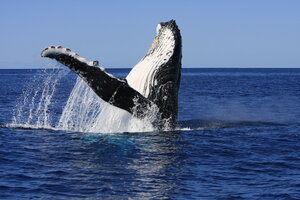~ecology-news-biolog | Bookmarks (441)
-
Humpback whale song shown to be structurally similar to human language
Language has long been considered a uniquely human trait, with features that mark it out as...
-
Restoring predators, restoring ecosystems: Yellowstone wolves and other carnivores drive strong trophic cascade
A new study reveals the profound ecological effects of wolves and other large carnivores in Yellowstone...
-
World's rarest marsupial shows signs of recovery after near extinction
A new review has documented the remarkable journey of Australia's most critically endangered marsupial, the Gilbert's...
-
Whale poop contains iron that may have helped fertilize past oceans
The blue whale is the largest animal on the planet. It consumes enormous quantities of tiny,...
-
Antarctic 'Hoff crab' males grow bigger claws to compete for mates around hot vents
New research has revealed that a hairy crustacean—dubbed "The Hoff crab" when it was discovered in...
-
Big moms make big impact—half of the coral trout caught on Great Barrier Reef found to be from marine reserves
A new study has found that nearly half the coral trout caught on the Great Barrier...
-
Estuary bacteria offer hope for pollutant detoxification in saline waters
Scientists from the Institute of Applied Ecology of the Chinese Academy of Sciences have identified a...
-
Pet flea treatments may be harming wildlife—but owners can help
Toxic substances used in flea and tick treatments pet owners give to their dogs and cats...
-
AI-powered analysis uncovers marine herbivores' impact on eelgrass disease spread
Eelgrass, a type of flowering seagrass found in temperate zones around the world, provides habitat for...
-
Scientists solve the mystery of sea turtles' 'lost years'
Using satellite trackers, scientists have discovered the whereabouts of young sea turtles during a key part...
-
Decades of agricultural research lead to biodiversity gains and improved sustainability
New, groundbreaking research shows how, at a local scale, agricultural research and development led to improved...
-
Human influence has led to loss of dialects in chimpanzees, long-term study suggests
A new study, conducted on wild chimpanzees (Pan troglodytes verus) in Taï National Park, Côte d'Ivoire,...
-
How eye saccades enable mammals to simultaneously chase prey and navigate through complex environments
How do predators use their vision to both navigate through the terrain while tracking prey running...
-
Thin leaves and strong roots gain ground in response to climate change
A recent study published in the Journal of Ecology, led by the UAB and CREAF, analyzes...
-
How African farmers are adapting to mountain climate change
A new international study highlights the severity of climate change impacts across African mountains, how farmers...
-
Decoding a butterfly's travel map: Scientists find globetrotting not in genes
Painted lady butterflies are world travelers. The ones we encounter in Europe fly from Africa to...
-
Identifying venom genes of parasitoid wasps: Successful parasitism without immediate host death
Parasitoid wasps, belonging to the family Hymenoptera, deprive their insect and spider hosts of nutrition. These...
-
Climate warming leads to more frequent tree reproduction at expense of growth, long-term study suggests
A new long-term study reveals alarming insights into the impact of climate change on the European...
-
Scientists hope these tiny froglets can save their species
It was quite the journey for such tiny froglets: traveling thousands of miles from the forests...
-
Grasslands study finds increasing fertilizer use drastically reduces the number of flowers and insects
A new study by researchers at the University of Sussex and Rothamsted Research published on Jan....
-
Scientists discover how cyst nematodes attack sugar beet crops
People love the taste of sugar beets' primary byproduct: white sugar. Soilborne cyst nematodes—parasitic, microscopic worms—enjoy...
-
Grasshoppers' size shifts reveal climate change winners and losers
As insect populations decrease worldwide in what some have called an "insect apocalypse," biologists are desperate...
-
Rats! More rodents are infesting cities as scientists say warmer temperatures mean more rat babies
Rat infestation in many world cities appears to be soaring, especially in Washington, and a new...
-
Genomic evidence confirms white shark liver is on Australian killer whales' menu
For the first time, DNA evidence has confirmed killer whales in Australia hunted a white shark...
























